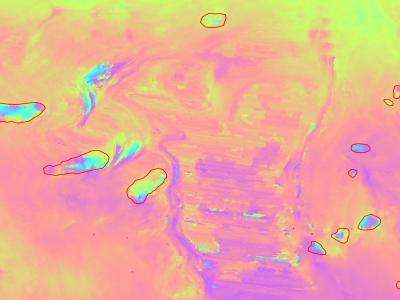Image Processing
The Numerical Latin Letters (DNLL) dataset consists of Latin numeric letters organized into 26 distinct letter classes, corresponding to the Latin alphabet. Each class within this dataset encompasses multiple letter forms, resulting in a diverse and extensive collection. These letters vary in color, size, writing style, thickness, background, orientation, luminosity, and other attributes, making the dataset highly comprehensive and rich.
- Categories:
 517 Views
517 ViewsOur large scale alpine land cover dataset consists of 229'535 very high-resolution aerial images (50cm) and digital elevation model (50cm) with land cover annotations produced by experts in photo-interpretration . The nine land cover types in our study area include bedrock, bedrock with grass, large blocks, large blocks with grass, scree, scree with grass, water area, forest and glacier. The distribution of pixels among classes presents a typical case of a long-tailed distribution with an imbalance factor, defined as the ratio of the most frequent to the rarest class, close to 1000.
- Categories:
 294 Views
294 ViewsQuantifying performance of methods for tracking and mapping tissue in endoscopic environments is essential for enabling image guidance and automation of medical interventions and surgery. Datasets developed so far either use rigid environments, visible markers, or require annotators to label salient points in videos after collection. These are respectively: not general, visible to algorithms, or costly and error-prone. We introduce a novel labeling methodology along with a dataset that uses said methodology, Surgical Tattoos in Infrared (STIR).
- Categories:
 2442 Views
2442 Views
This dataset, presents the results of motion detection experiments conducted on five distinct datasets sourced from changedetection.net: bungalows, boats, highway, fall and pedestrians. The motion detection process was executed using two distinct algorithms: the original ViBe algorithm proposed by Barnich et al. (G-ViBe) and the CCTV-optimized ViBe algorithm known as α-ViBe.
- Categories:
 246 Views
246 Views
This dataset, presents the results of motion detection experiments conducted on five distinct datasets sourced from changedetection.net: bungalows, boats, highway, fall and pedestrians. The motion detection process was executed using two distinct algorithms: the original ViBe algorithm proposed by Barnich et al. (G-ViBe) and the CCTV-optimized ViBe algorithm known as α-ViBe.
- Categories:
 183 Views
183 ViewsMapping millions of buried landmines rapidly and removing them cost-effectively is supremely important to avoid their potential risks and ease this labour-intensive task. Deploying uninhabited vehicles equipped with multiple remote sensing modalities seems to be an ideal option for performing this task in a non-invasive fashion. This report provides researchers with vision-based remote sensing imagery datasets obtained from a real landmine field in Croatia that incorporated an autonomous uninhabited aerial vehicle (UAV), the so-called LMUAV.
- Categories:
 1378 Views
1378 ViewsSlow moving motions are mostly tackled by using the phase information of Synthetic Aperture Radar (SAR) images through Interferometric SAR (InSAR) approaches based on machine and deep learning. Nevertheless, to the best of our knowledge, there is no dataset adapted to machine learning approaches and targeting slow ground motion detections. With this dataset, we propose a new InSAR dataset for Slow SLIding areas DEtections (ISSLIDE) with machine learning. The dataset is composed of standardly processed interferograms and manual annotations created following geomorphologist strategies.
- Categories:
 1266 Views
1266 Views
The "ShrimpView: A Versatile Dataset for Shrimp Detection and Recognition" is a meticulously curated collection of 10,000 samples (each with 11 attributes) designed to facilitate the training of deep learning models for shrimp detection and classification. Each sample in this dataset is associated with an image and accompanied by 11 categorical attributes.
- Categories:
 1584 Views
1584 ViewsLight-matter interactions within indoor environments are significantly depolarizing. Nonetheless, the relatively small polarization attributes are informative. To make use of this information, polarized-BRDF (pBRDF) models for common indoor materials are sought. Fresnel reflection and diffuse partial polarization are popular terms in pBRDF models, but the relative contribution of each is highly material-dependent and changes based on scattering geometry and albedo.
- Categories:
 147 Views
147 ViewsRecognizing and categorizing banknotes is a crucial task, especially for individuals with visual impairments. It plays a vital role in assisting them with everyday financial transactions, such as making purchases or accessing their workplaces or educational institutions. The primary objectives for creating this dataset were as follows:
- Categories:
 340 Views
340 Views





